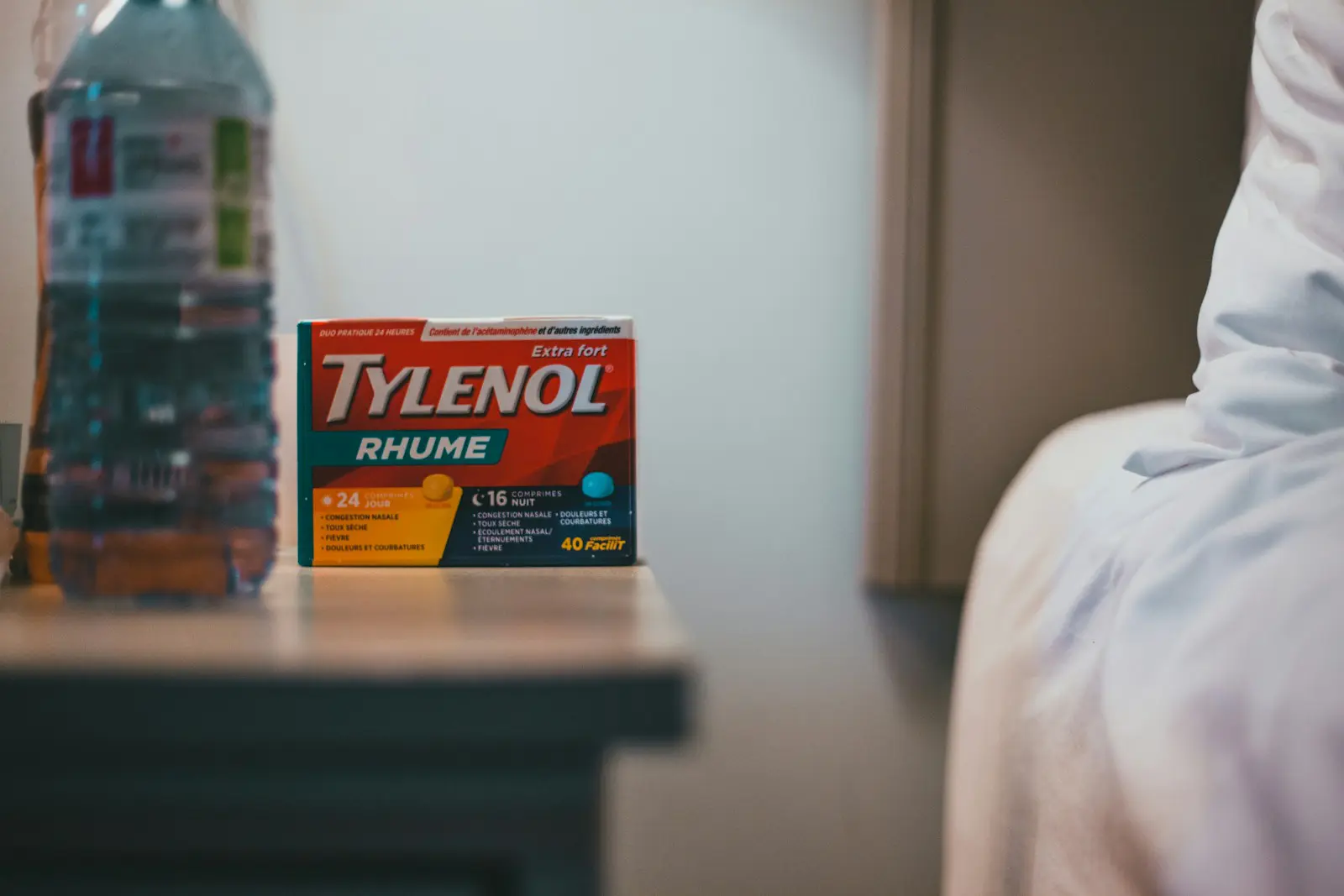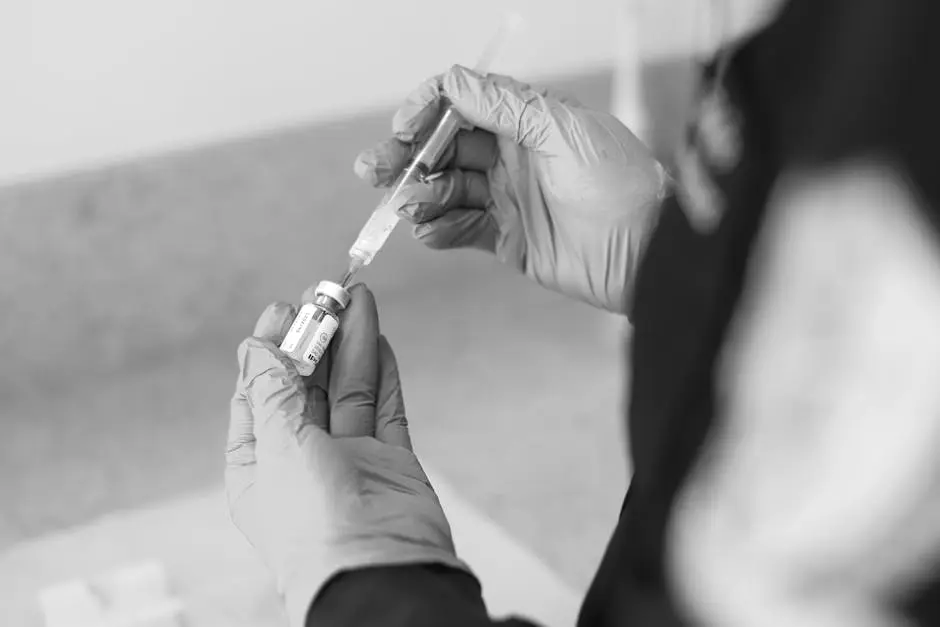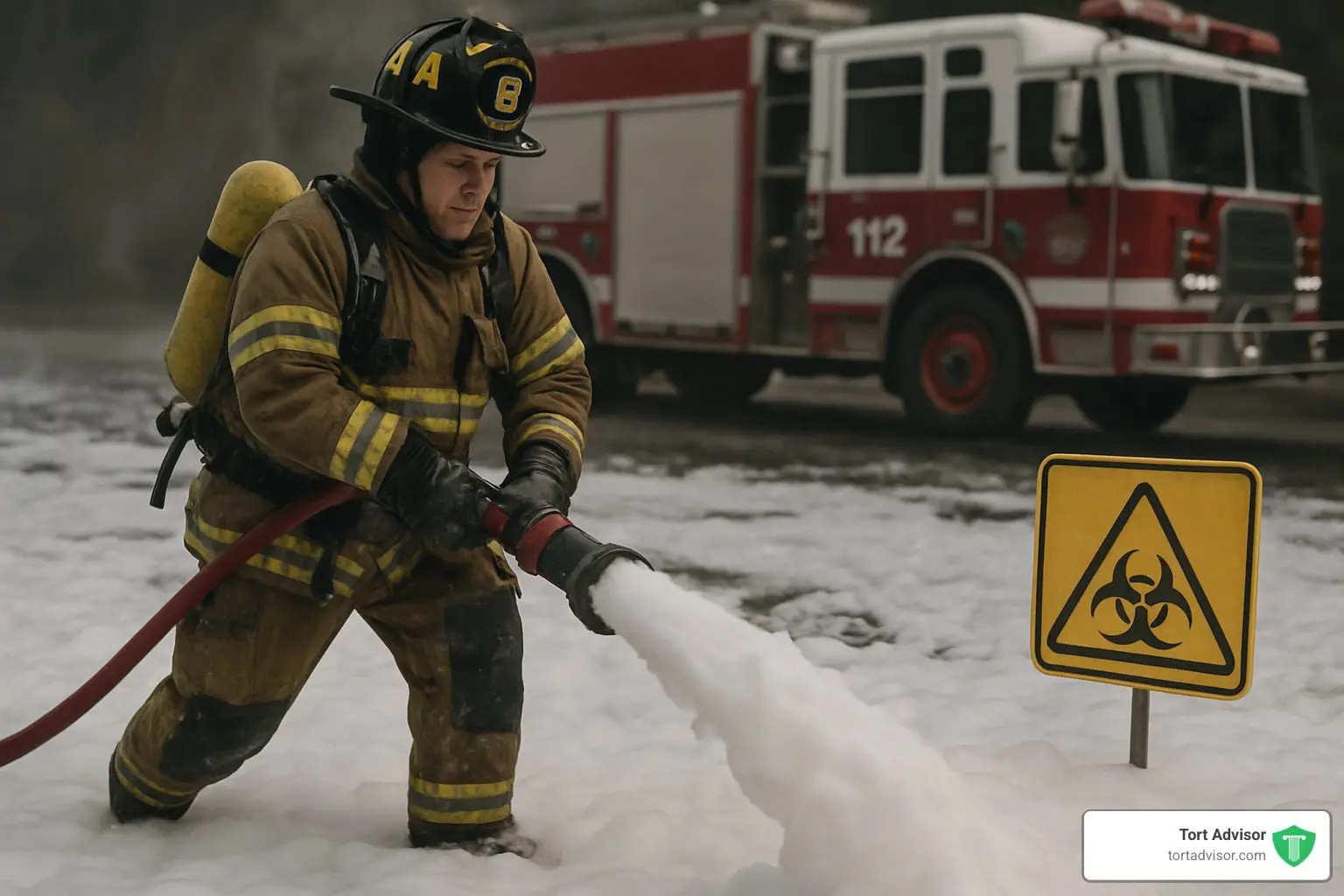


Why Firefighting Foam Cancer Lawsuits Are Exploding Across America
The firefighting foam cancer lawsuit epidemic has reached a tipping point, with over 8,900 claims now consolidated in federal court as firefighters and military personnel fight for justice against manufacturers who knew their products caused cancer.
Quick Answer for Firefighting Foam Cancer Lawsuit Searches:
- What it is: Lawsuits against foam manufacturers (3M, DuPont, Tyco) for cancer-causing PFAS chemicals in AFFF firefighting foam
- Who qualifies: Firefighters, military personnel, airport crews with cancer diagnoses after AFFF exposure
- Current status: 8,900+ cases in MDL 2873; first trials scheduled October 2025
- Settlements so far: $10.3 billion (3M water contamination), $1.18 billion (DuPont), $730 million (Carrier)
- Covered cancers: Kidney, testicular, liver, thyroid, pancreatic, bladder, prostate, breast cancers
- Filing deadline: Varies by state (typically 2-3 years from diagnosis)
- Cost to file: No upfront fees – attorneys work on contingency
For decades, aqueous film-forming foam (AFFF) has been the gold standard for fighting jet fuel and petroleum fires. But this “miracle foam” contains PFAS chemicals – dubbed “forever chemicals” because they never break down in the environment or human body.
The science is now crystal clear: PFAS exposure dramatically increases cancer risk. Studies show firefighters face a 56% higher risk of thyroid cancer and liftd rates of kidney and testicular cancers. Yet manufacturers like 3M and DuPont knew about these dangers as early as the 1970s but continued marketing AFFF as safe.
The legal reckoning is massive. With 8,430 pending cases as of March 2025 and 498 new filings added just last month, this litigation rivals the largest mass torts in history. The first bellwether trials begin October 2025, focusing on kidney and testicular cancer claims.
What makes this especially tragic is that safer alternatives existed – but manufacturers prioritized profits over firefighter safety. Now, as the Pentagon phases out PFAS foam by 2028 and states ban toxic formulations, thousands of heroes who risked their lives are battling cancer.

AFFF & “Forever Chemicals”: What You’re Really Spraying
When you grab that AFFF canister, you’re actually spraying a chemical cocktail that’s been quietly poisoning firefighters since the U.S. Navy and 3M first patented it back in 1966.
The foam works so well because it’s loaded with per- and polyfluoroalkyl substances (PFAS) – synthetic chemicals that were engineered to be tougher than anything nature ever created. They resist heat, water, and oil with an almost supernatural stubbornness.
Inside every drop of AFFF, you’ll find dangerous PFAS compounds like PFOA (perfluorooctanoic acid) and PFOS (perfluorooctane sulfonic acid). These create that signature “aqueous film” spreading across burning jet fuel, cutting off oxygen and snuffing out the flames.
But here’s the cruel irony: the same properties that make AFFF so good at fighting fires make it devastating to human health. According to EPA research on PFAS health risks, these compounds resist every natural process that normally breaks down chemicals in our environment and bodies.
Why PFAS Are Called Forever Chemicals
The nickname “forever chemicals” isn’t marketing – it’s cold, hard science. PFAS molecules contain carbon-fluorine bonds that rank among the strongest connections in all of organic chemistry. While most chemicals break down in days or months, PFAS can persist for decades.
This creates a nightmare scenario. Bio-accumulation means PFAS build up in your tissues faster than your body can eliminate them. Water contamination spreads the problem beyond individual firefighters. Soil retention means PFAS stay put at fire stations indefinitely.
Studies show PFAS can be detected in 97% of Americans’ blood, but firefighters show concentrations 2-3 times higher. These chemicals concentrate in vital organs like the liver and kidneys, creating perfect conditions for cancer development.
Classes of Firefighting Foam—Not All Are Equal
Class A foams tackle structural fires and typically don’t contain PFAS. Class B foams fight flammable liquid fires and most contain dangerous PFAS. Legacy PFOS AFFF used from the 1960s through 2002 contains the most toxic compounds. The only truly safe option is fluorine-free foams – PFAS-free alternatives finally gaining adoption.
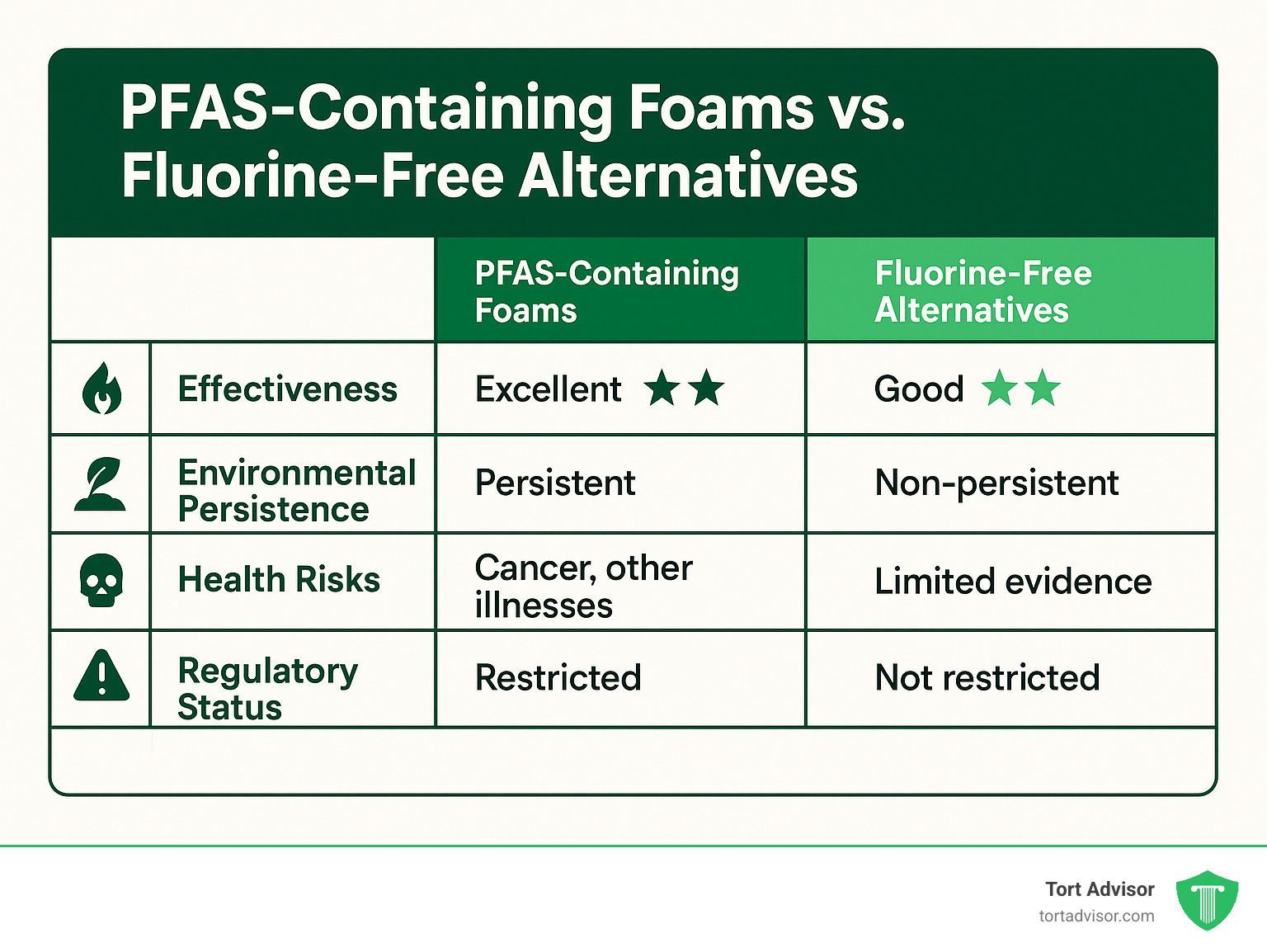
How Exposure to AFFF Triggers firefighting foam Cancer & Other Diseases
The journey from foam exposure to cancer diagnosis isn’t mysterious – scientists have mapped exactly how these “forever chemicals” wreak havoc in our bodies. When firefighters spray AFFF, they’re opening multiple pathways for PFAS to enter their system.
Skin absorption happens faster than most realize. Inhalation occurs when foam creates airborne particles. Ingestion happens through contaminated water supplies. Once inside, these chemicals head straight for your organs – particularly your kidneys, liver, and thyroid.
The cancer risks are staggering. Firefighters face a 67% increased risk of kidney cancer when heavily exposed to AFFF. Testicular cancer rates jump 2-3 times higher. Liver cancer, thyroid cancer, pancreatic cancer, and other cancers all show strong links to AFFF exposure.
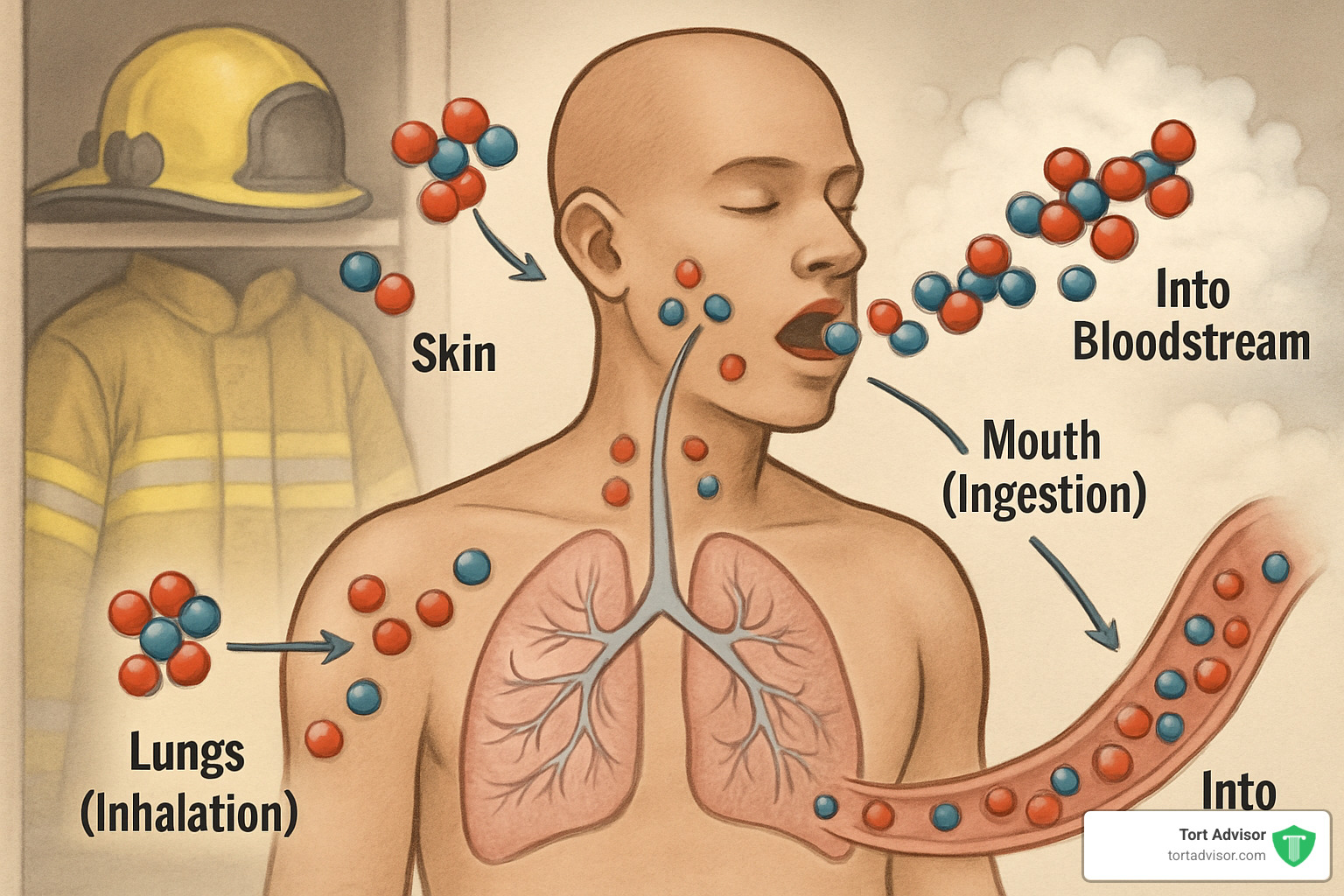
The Science Linking Foam to Tumors
The evidence keeps getting stronger. Research on testicular cancer from the National Cancer Institute shows exactly how PFAS sabotage your body’s defenses.
PFAS interfere with DNA repair, trigger chronic inflammation, and disrupt normal cell division. Most disturbing, PFAS overwhelm your detoxification systems. Your liver and kidneys can’t eliminate these indestructible chemicals, so they accumulate year after year.
When researchers test blood samples, firefighters with cancer consistently show significantly higher PFAS levels than healthy firefighters. This dose-response evidence directly links foam exposure to cancer development.
Beyond Cancer: Additional Health Risks
Fertility problems hit both men and women. High cholesterol becomes chronic. Your immune system takes a beating. Bone density loss accelerates aging. These health issues serve as early warning signs and strengthen legal claims by showing a pattern of harm building toward cancer diagnosis.
Who’s at Greatest Risk & Key Evidence to Prove Your Claim
Professional firefighters face the most dangerous occupational exposure. The CDC reveals 72% of line-of-duty deaths in 2023 were caused by occupational cancer. Military personnel represent the largest exposed group – the DoD has been responsible for 75% of AFFF usage since the 1960s. Airport ARFF crews were required by the FAA to use PFAS foam from 1988 to 2018. Refinery and industrial workers also face significant risks.
For more details, check our guide on PFAS Exposure Risks.
Building the Evidence File
Winning requires proving the connection between your illness and AFFF exposure. Employment records establish when and where you were exposed. Medical diagnoses with complete pathology reports are crucial. Exposure logs from training exercises and emergency responses strengthen claims. EPA site data provides independent contamination verification. Witness statements from colleagues add credibility.
The key is gathering evidence while it’s still available. Records get lost, witnesses move away, and memories fade.
The Firefighting Foam Cancer Lawsuit Landscape (MDL 2873)
The firefighting foam cancer lawsuit battle has become one of the largest mass tort cases in American history. Over 8,900 cases are consolidated under Judge Richard Gergel in South Carolina’s federal court, representing thousands fighting for justice.
Just last month, 498 new cases were filed, showing explosive growth. Defendants include 3M Company, DuPont and Chemours, Tyco Fire Products, BASF Corporation, and Chemguard Inc.

Current Status
The MDL focuses on six core injuries: kidney cancer, testicular cancer, ulcerative colitis, thyroid disease, liver cancer, and thyroid cancer. First bellwether trials are scheduled for October 2025. For updates, see our guide on AFFF Firefighting Foam Lawsuits.
Major Settlements
3M’s $10.3 billion settlement resolved water contamination claims. DuPont’s $1.185 billion and Carrier’s $730 million settlements show these companies have deep pockets. Legal experts predict individual settlements of $175,000 to $500,000, with jury verdicts potentially exceeding $2.5 million.
Companies Being Sued & Defenses
Over 25 companies face liability. Their government contractor defense failed spectacularly in 3M earplug litigation. Preemption arguments are consistently rejected. Internal documents show companies knew PFAS accumulated in human blood since the 1970s but never warned users – opening the door to punitive damages.
Filing Your Own Firefighting Foam Cancer Lawsuit
If you’ve been exposed to AFFF and developed cancer, you need proof of exposure and a qualifying diagnosis. Kidney and testicular cancers have the strongest scientific backing. Other covered cancers include liver, thyroid, pancreatic, bladder, prostate, breast, and colorectal cancers, plus leukemia, lymphoma, and ulcerative colitis.
Most states give you 2-3 years to file from diagnosis date. Military veterans can typically pursue both VA disability claims and firefighting foam cancer lawsuit compensation simultaneously. Wrongful death claims are possible but face stricter deadlines.
Attorneys work on contingency fees – you pay nothing unless you win. For more information, see our PFAS Cancer Lawsuit resource.
Step-by-Step Process
Everything starts with a free consultation. During case investigation, legal teams gather employment records and medical files. Filing joins your case with thousands of others in federal court. Most cases resolve through settlement negotiation. The process typically takes 2-4 years.
Potential Compensation
Medical expenses cover past and future treatment. Lost wages include missed work and reduced earning capacity. Pain and suffering acknowledges cancer’s emotional toll. Future care costs address ongoing needs. Punitive damages punish corporate misconduct and can dramatically increase compensation.
Life After AFFF: Safer Foams & Regulations
The tide is turning against toxic foam. The FAA is transitioning airports away from PFAS foam. The Department of Defense commits to eliminating PFAS foam by 2028. State-level bans are gaining momentum in California, New York, and Washington.
Fluorine-free foam adoption is accelerating. For current users, personal protective equipment upgrades and blood testing for PFAS levels can help. These changes won’t help those already fighting cancer, but they’re preventing future tragedies.
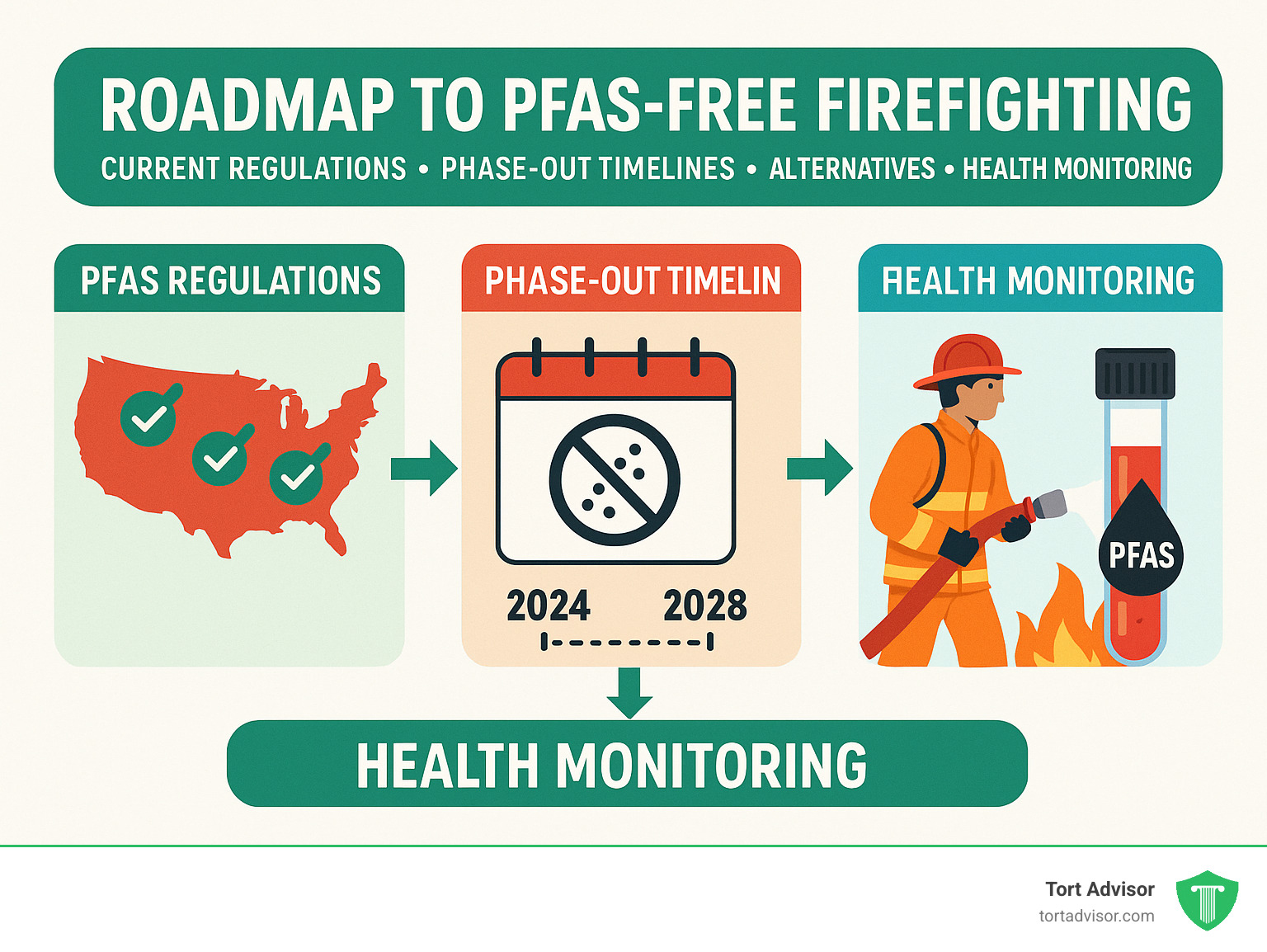
Frequently Asked Questions
What cancers are covered?
Firefighting foam cancer lawsuit cases cover cancers with strong scientific links to PFAS exposure. The strongest cases involve kidney cancer, testicular cancer, liver cancer, thyroid cancer, and pancreatic cancer. Other qualifying cancers include bladder, prostate, breast, and colorectal cancers, plus leukemia, lymphoma, and ulcerative colitis.
How long do I have to file?
Most states give you 2-3 years to file from your cancer diagnosis date, not from exposure. The “findy rule” means your deadline starts when you reasonably should have known your cancer was caused by AFFF. Don’t wait – every state has different rules and missing your deadline means losing compensation forever.
Can I still file if I receive VA benefits?
Yes, absolutely. VA benefits and civil lawsuits are separate legal matters. VA benefits compensate for service-connected disabilities while lawsuits seek damages from manufacturers. Most military firefighters pursue both simultaneously, and compensation from each typically doesn’t reduce the other.
Conclusion
The firefighting foam cancer lawsuit crisis has exposed one of the most devastating corporate cover-ups in American history. For decades, manufacturers like 3M and DuPont knew their foam contained cancer-causing chemicals but chose profits over firefighter safety.
The numbers are heartbreaking: over 8,900 cases filed, with hundreds more added monthly. Behind every case is a hero who protected others, only to face cancer years later. The science is crystal clear – PFAS chemicals build up in your body for decades, triggering devastating diseases.
But there’s hope. $12 billion in settlements have been paid for water contamination. The first personal injury trials start October 2025, with experts predicting individual settlements reaching $500,000 or more.
If you developed cancer after AFFF exposure, time is running out. Statutes of limitations are ticking and evidence needs preservation. The manufacturers are hoping you’ll give up or wait too long. Don’t let them win.
At Tort Advisor, we connect victims with attorneys who’ve mastered PFAS toxicity science and have resources to take on billion-dollar corporations. These specialists work on contingency – you pay nothing unless they win.
Your fight isn’t just about compensation – it’s about accountability and getting justice for heroes who sacrificed their health protecting others.
For comprehensive information about pursuing your claim and connecting with experienced attorneys, visit our detailed resource on AFFF Firefighting Foam Lawsuits. These attorneys have dedicated their careers to fighting for people just like you.
Your service protected others. Now let us help protect you.
Free Confidential Case Evaluation
Complete the short form below to get an immediate FREE case review with an expert in your specific claim. Don't wait, your case could be time sensitive to file a claim.
Related Posts
The Tylenol autism lawsuit represents one of the most significant pharmaceutical litigation cases of recent years, with hundreds of families [...]
Facing a denied disability claim? Discover denial reasons, the appeal steps, and key strategies to win your benefits. Act now!
Need a motor vehicle accident attorney Kansas City? Learn immediate steps, state laws, and how to get maximum compensation after your crash.
Secure financial relief. Learn to navigate Victim compensation fund programs, eligibility, and the application process for crime-related expenses.
Get expert disability claim assistance. Navigate SSDI, SSI, or VA benefits with confidence. Avoid denials & win your claim!
Discover serious depo-provera lawsuit side effects like brain tumors & bone loss. Learn if you qualify for compensation and seek legal help.

